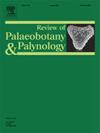Callixylon seamrogia sp. nov., a new species from the uppermost Famennian (Upper Devonian) of Ireland
IF 1.7
3区 地球科学
Q2 PALEONTOLOGY
引用次数: 0
Abstract
The fossil record of the Devonian tree Archaeopteris/Callixylon is extensive worldwide, however, the underground parts of these plants remain scarcely known. To date, there are only three studies that provide detailed anatomical descriptions of their roots. This study describes new anatomically preserved roots and stems of Callixylon from uppermost Famennian (Upper Devonian) deposits of Sandeel Bay, County Wexford, Ireland. The wood is characterized by tracheids with the pitting pattern typical of Callixylon (i.e., radial pits forming groups separated by non-pitted areas), and the presence of numerous ray tracheids that are smaller than the parenchyma ray cells in tangential section and unevenly arranged inside the rays. The roots are characterized by a three-lobed actinostele with multiple exarch protoxylem strands, an unusual organization reported for the first time in Callixylon roots. The stems are eustelic, with a heterocellular pith composed of thin and some thick-walled cells. Based on their unique combination of characters, the specimens are assigned to a new species, Callixylon seamrogia, the first species of Callixylon reported from Ireland. Based on comparisons with previous architectural studies of Callixylon, the stems are hypothesized to correspond to main axes of the new species, one of them bearing an apically emitted non-persistent branch. These new specimens from Ireland provide new information on the rooting system of Archaeopteris/Callixylon and improve our understanding of the anatomical and systematic diversity within the genus.
爱尔兰上泥盆统(上泥盆统)一新种
泥盆纪古树始祖树(Archaeopteris/Callixylon)的化石记录在世界范围内广泛存在,然而,这些植物的地下部分仍然鲜为人知。迄今为止,只有三项研究提供了它们根部的详细解剖描述。本研究描述了在爱尔兰韦克斯福德郡Sandeel Bay的上泥盆世(上泥盆世)沉积物中发现的新的解剖保存的Callixylon根和茎。木材的特征是管胞具有典型的刺蚀模式(即径向凹坑形成群,被非凹坑区隔开),并且存在大量的射线管胞,它们比切切面上的薄壁射线细胞小,并且在射线内排列不均匀。根具有三裂放线骨和多根原木质部,这是在梭梭根中首次报道的一种不寻常的组织结构。茎柱状,具有由薄壁细胞和一些厚壁细胞组成的异细胞髓。根据其独特的性状组合,这些标本被分配给一个新种,Callixylon seamrogia,这是爱尔兰报道的第一个Callixylon物种。通过与以往的结构研究的比较,我们假设这些茎与新物种的主轴相对应,其中一个茎上有一个顶端发出的非宿存分支。这些来自爱尔兰的新标本提供了关于始祖鸟(Archaeopteris/Callixylon)生根系统的新信息,并提高了我们对该属的解剖学和系统多样性的理解。
本文章由计算机程序翻译,如有差异,请以英文原文为准。
求助全文
约1分钟内获得全文
求助全文
来源期刊
CiteScore
3.50
自引率
21.10%
发文量
149
审稿时长
6 months
期刊介绍:
The Review of Palaeobotany and Palynology is an international journal for articles in all fields of palaeobotany and palynology dealing with all groups, ranging from marine palynomorphs to higher land plants. Original contributions and comprehensive review papers should appeal to an international audience. Typical topics include but are not restricted to systematics, evolution, palaeobiology, palaeoecology, biostratigraphy, biochronology, palaeoclimatology, paleogeography, taphonomy, palaeoenvironmental reconstructions, vegetation history, and practical applications of palaeobotany and palynology, e.g. in coal and petroleum geology and archaeology. The journal especially encourages the publication of articles in which palaeobotany and palynology are applied for solving fundamental geological and biological problems as well as innovative and interdisciplinary approaches.

 求助内容:
求助内容: 应助结果提醒方式:
应助结果提醒方式:


